Entries from August 1, 2012 - August 31, 2012
UK money acceleration argues against MPC easing
UK monetary trends continue to signal an economic pick-up in late 2012, in contrast to consensus gloom. Stronger nominal money growth, however, will face an increased inflation headwind over coming months, probably preventing further real acceleration. This highlights the economic cost of the Bank of England’s failure to achieve its inflation target.
Underlying monetary trends are arguably best assessed using money supply measures that exclude the volatile holdings of financial corporations. Non-financial M4 and M1 (i.e. covering holdings of households and private non-financial corporations) rose by 4.6% and 4.1% in the 12 months to July – the strongest since September 2008 and July 2010 respectively.
The chart compares the two-quarter change in GDP excluding oil and gas extraction with six-month changes in real non-financial M4 and M1 (i.e. deflated by seasonally-adjusted consumer prices, not annualised). Economic weakness in early 2012 followed real money contraction in 2011. The real money measures have recently expanded at rates last reached in 2009-10 ahead of a period of solid economic growth.
Real money expansion, however, may stabilise or fall back slightly over coming months as inflation rebounds. The inflation forecast presented in a post last week implies that the six-month change in seasonally-adjusted consumer prices will rise from 1.0% in July to 2.1% by January 2013 (not annualised). Nominal money trends may not improve sufficiently to offset this increased drag. Such a scenario would suggest a stabilisation of economic growth next spring following a pick-up over the winter.
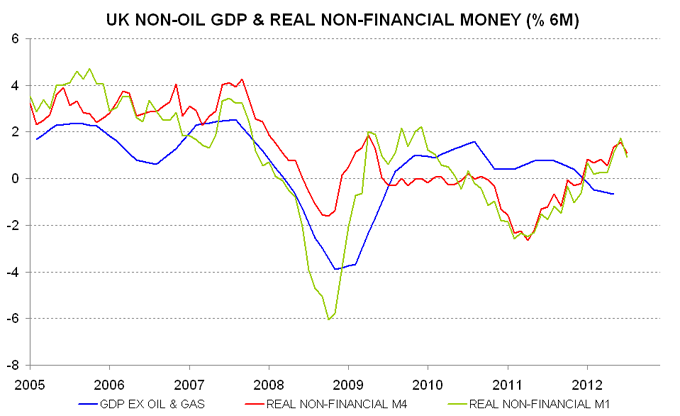
Eurozone monetary pick-up signalling German-led recovery
Eurozone monetary statistics for July confirm an improving economic outlook, with six-month growth rates of real M1 and M3 (i.e. deflated by consumer prices) reaching their highest levels since July 2010 and March 2009 respectively. Real M1 is the “best” monetary forecasting indicator of the economy, contracting before the 2008-09 and 2011-12 recessions and rebounding ahead of the intervening recovery – see first chart. It bottomed in April 2012, suggesting that the Eurozone economy will trough this autumn and revive into 2013, allowing for the usual half-year lead.
The turnaround in economic prospects is likely to be missed by a consensus focused on continued weakness in bank lending to the private sector. The money supply is picking up despite credit weakness because of recent bank purchases of government bonds and a shift of funds out of longer-term bank savings instruments into deposits. The latter trend should be sustained following further falls in interest rates and shows that these are working to change behaviour – a transfer of savings into more liquid forms is a precursor of higher spending. Bank buying of government bonds has slowed recently but the ECB’s planned intervention scheme may take up any slack. (Credit usually lags money – in 2008-09, private sector loans bottomed more than a year after M1.)
Real M1 rose by 2.2%, or 4.4% annualised, in the six months to July. M1 comprises currency in circulation and overnight deposits. The ECB provides a country breakdown of deposits but not currency. A 2.1% rise in Eurozone real overnight deposits in the six months to July reflects a strong 4.6% increase in “core” countries offset by a 2.1% decline in the periphery (i.e. Greece, Ireland, Italy, Portugal, Spain) – second chart. Within the core, German real overnight deposits surged by 6.3%, or 13.0% annualised, suggesting that the economy will boom next year – see previous post. French real deposits, by contrast, have contracted recently – third chart.
The continued fall in peripheral real overnight deposits is disappointing, signalling no end to recessions this year, but the decline has – Spain excepted – slowed. Recent and prospective ECB actions promise improvement, in part by lifting confidence, thereby stemming or reversing capital flight. Core / periphery monetary divergence is of less concern when Eurozone-wide real M1 is rising solidly – a gap is desirable to promote economic rebalancing.
The key risk in the current monetary constellation is that prospective German buoyancy results in the Bundesbank and its allies demanding that the ECB rein in stimulus, repeating the 2010-11 policy debacle that laid the foundations for the current recession. ECB President Draghi, however, has skilfully outmanoeuvred the hardliners by designing policies that command strong support – to the extent that the Bundesbank chief is now isolated even from Germany’s representative on the ECB’s executive board.


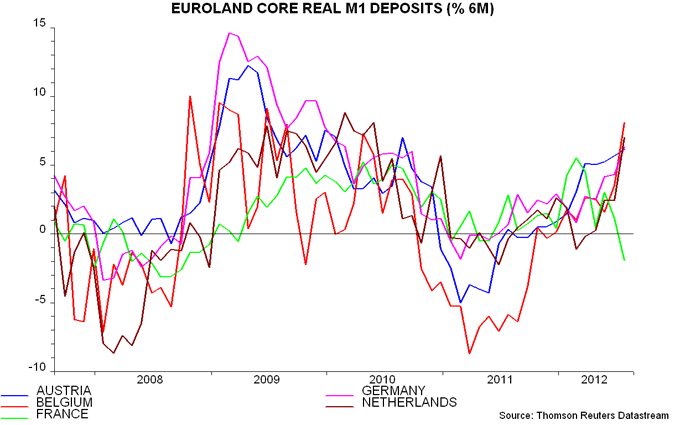
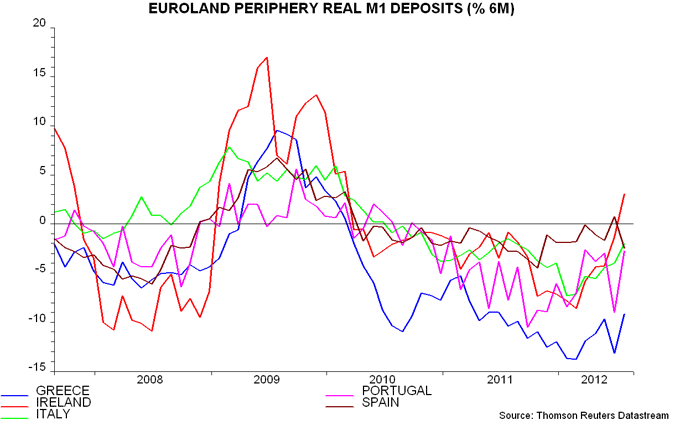
Rising risk of more King letter-writing
Has he called the turn again? At the August 2009 Inflation Report press conference, Bank of England Governor Mervyn King opined, “It is more likely than not that later this year I will need to write a letter to the Chancellor to explain why inflation has fallen more than one percentage point below the target.” CPI inflation bottomed at 1.1% the following month before surging to 3.5% in January 2010, requiring Mr King to find excuses in the opposite direction.
Fast forward to the Governor’s self-congratulatory opening remarks at this month’s press conference. “A year ago inflation was rising and heading towards 5%. It has now fallen to within touching distance of the 2% target. The big picture in today’s Report is of a further decline in inflation, as external influences fade and domestic cost pressures ease …” Unlikely before, this forecast has been torpedoed by the recent rise in energy and food commodity prices. CPI inflation may bottom at 2.1% in September and rebound to 3.1% by January, forcing the Governor to resume letter-writing duties – see first chart for a possible profile.
The forecast assumes that:
-
Unleaded petrol rises to £1.45 per litre by January 2013 to reflect current wholesale gasoline costs and a scheduled 3 pence duty hike, with a comparable increase for diesel.
-
Energy companies follow SSE’s lead and raise household gas and electricity tariffs by an average 7.5% this autumn (SSE announced a 9% increase this week, to take effect in October).
-
Unprocessed food inflation rebounds from 2.3% in July to 5% (possibly conservative given a 12.7% rise in the producer input price index for home-produced food in the year to July – second chart).
-
Higher undergraduate tuition fees add 0.2 percentage points to CPI inflation from October.
-
“Core” inflation – i.e. excluding the above factors – runs at 2.4%, the average of the last five years (after adjusting for VAT changes), variance around which has been small despite economic upheavals.
No allowance has been made for the possibility that Chancellor Osborne will attempt to plug the emerging gap in his fiscal plans with another VAT hike or outsized rises in excise duties.
The Bank of England, of course, will argue that it should not be held responsible for an inflation rise caused by commodity price strength related to actual or feared supply shortages. This defence, however, will be unconvincing if, as expected, core inflation remains above 2%. Upward pressure on commodity prices, moreover, has been fuelled by the additional liquidity injected by G7 central banks in knee-jerk response to economic weakness, with the Bank in the vanguard of monetary experimentation.
The Governor’s persistent tendency to underpredict inflation is judged here to reflect dogged adherence to a broken model rather than a sly attempt to exploit a supposed trade-off with growth and / or “inflate away” debt. The MPC’s inflation-fighting credibility, nevertheless, would be enhanced by the appointment of a successor able to demonstrate a better forecasting record and less prone to hubristic wishful thinking.
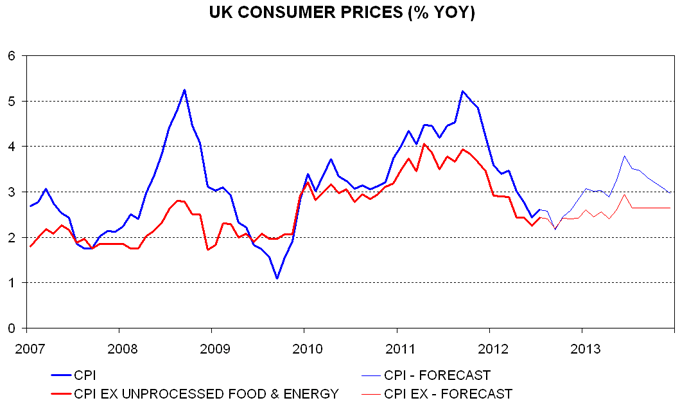
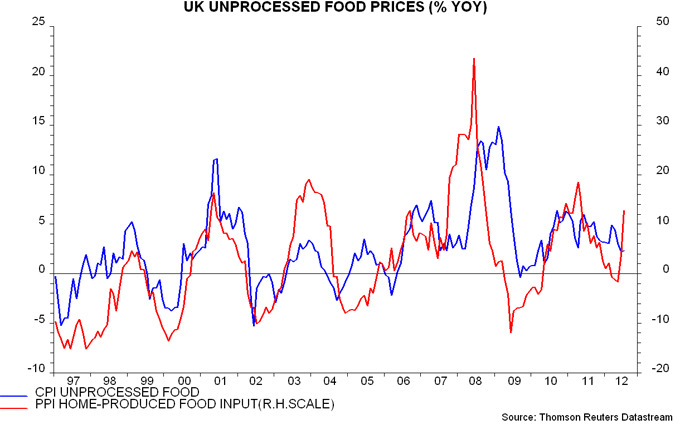
Global equities: too much, too soon?
The fall in global six-month real narrow money expansion to a low in April / May argues that economic momentum will continue to slow into October / November. Markets have been buoyed recently by some better economic data but the odds are that near-term news will disappoint.
An immediate risk is further weakness in August manufacturing purchasing managers’ surveys – “flash” readings for the Eurozone, China and the US are released tomorrow. Such weakness is suggested by both a slide in the world equity earnings revisions ratio to a three-year low and last month’s downbeat Federation of Korean Industries survey, which often leads – see first and second charts.
A recovery in global real money expansion since the spring has underpinned the rally in equities but markets have arguably run ahead of economic “fundamentals” while commodity price strength risks derailing the real money pick-up – see Monday’s post. A post in May noted that US equities were following a similar pattern in 2012 to 1987, with this “template” suggesting a strong summer rally to an August peak. The similarity has persisted – third chart – and now argues for caution.
The expectation here is that any near-term market weakness will, in contrast to 1987, be limited and temporary. A key difference is the monetary backdrop – global real money growth was below industrial output expansion and falling ahead of the 1987 crash but is now above and rising. Investor sentiment and positioning, meanwhile, had reached a bullish extreme in August 1987 but remain conservative currently – fourth chart
.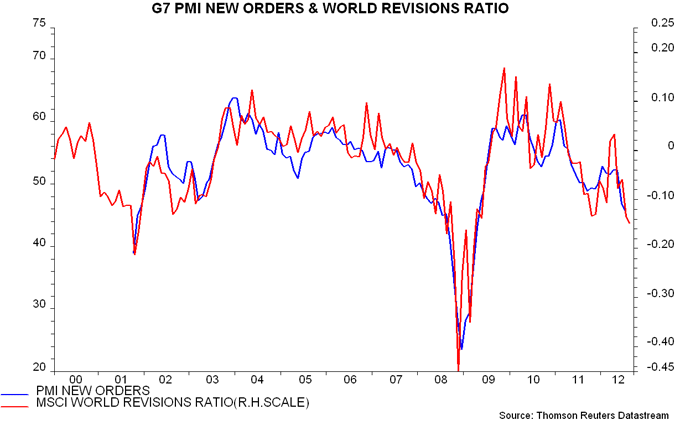
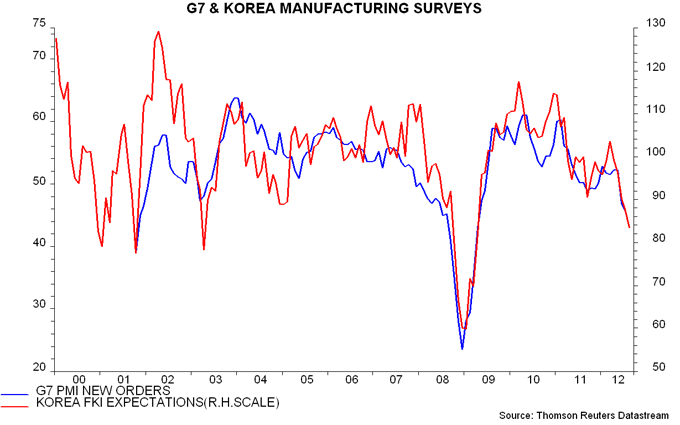


Europeriphery news improving at margin
Economic prospects for Eurozone peripheral economies remain grim but some recent news has been less negative:
-
Real money contraction – which predicted the current fall in output – has slowed. Indeed, aggregate real M1 deposits in Greece, Ireland, Italy, Portugal and Spain were unchanged between February and June, suggesting economic stabilisation in late 2012. (July figures are released next week.)
-
Euro weakness and cost containment have improved external competitiveness. Relative unit labour costs in the five economies fell by between 1.3% and 7.1% between the third quarter of 2010 and the first quarter of 2012, according to the ECB’s real effective exchange rates (REERs) – see previous post. Spain’s REER is now below its EMU starting level.
-
The aggregate trade balance of the five economies was in surplus in June for the first time since EMU’s inception – see first chart. This mainly reflects a fall in imports related to slumping domestic demand but exports have been growing modestly despite weak destination markets and credit constraints – second chart.
-
ECB lending to the Eurozone banking system has stabilised since mid-year, consistent with a slowdown in capital flight from the periphery.
-
Greece still needs to agree and implement substantial new cost-cutting measures but official state budget numbers suggest that this year's planned deficit reduction is on track – the primary shortfall declined to 1.8% of GDP in the 12 months to July.
These developments are insufficient to warrant optimism but the improvement in news at the margin may increase the chances of new policy initiatives – such as the Draghi bond-buying plan – succeeding in turning around market sentiment.


Global real money growth up again but inflation drag to rise
G7 plus emerging E7 six-month real narrow money expansion – the key cycle forecasting tool employed here – appears to have risen further in July, confirming April / May as a trough and suggesting that the global economy will regain momentum in late 2012 / early 2013, allowing for the usual half-year lead. The real money pick-up, however, is at risk from a rebound in inflation.
The global real money measure plunged between December and February, signalling the recent loss of industrial momentum – see first chart. It continued to edge lower into the spring before rebounding in June, with the recovery extending in July, based on data for the US, Japan, Brazil, China and India – second chart. The July improvement mainly reflects a sharp increase in China – see previous post. The final July reading will depend importantly on Eurozone numbers released on 28 August.
Monetary policy easing may boost nominal money supply expansion through the second half but real growth may be curbed by a rebound in inflation in response to recent gains in energy and food commodity prices – third chart. Commodity price strength, in other words, could dampen economic prospects beyond early 2013, thereby presenting a risk to the current rally in equities.




